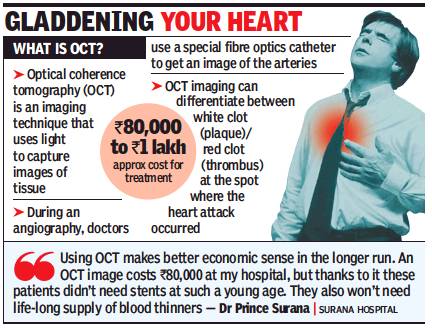‘Near Infrared Light’ Looks Inside Heart Arteries
Now, Chembur hospital doc says goodbye to stents, blood thinners

Mumbai:
When 24-year-old Varun Shinde, a graphic designer, started puking and felt too weak to move, little did he or his parents think he was having a heart attack. But, thanks to a comparatively new technology called ocular coherence tomography (OCT), he did not need major procedures such as cardiac bypass or angioplasty. OCT uses ‘near infrared light’ to visualise the inside of heart arteries.
“Using OCT along with angiography, we could establish that Varun’s heart attack was caused by a blood clot and not due to plaque rupture,’’ said cardiologist Dr V T Shah, who treated Varun at Surana Hospital, Chembur, in January.
Varun is happy that he only needed oral medicines. “The second angiography a month later showed that the clot that caused the heart attack had disappeared,’’ he said.
Heart attacks are the leading cause of deaths among Indians, claiming over 28 lakh lives in 2016. Indians are genetically prone to get heart attacks a decade earlier than Caucasians, say studies. But, heart attacks among people in their 20s is another cause for concern among Indian doctors. But Dr Shah believes newer techniques such as OCT can refine treatment for youngsters and prevent unnecessary stenting.
While all patients of heart attacks are put through an angiography — a procedure that uses X-rays and a special dye to take pictures of the heart and arteries — it only shows hazy lesions in the arteries; there is no clear distinction between a blood clot and a plaque rupture.
OCT helps doctors see lesions closer and clearly as it can measure thickness of up to 10 microns. It thus provides information about the nature of the plaque, extent of narrowing of the coronary artery and helps doctors choose the size and length of the stent better.
Prior to Varun, the Chembur hospital had treated two young patients similarly. A 28-year-old Navi Mumbai municipal corporation employee, Kishore (name changed), suffered a heart attack a month before his wedding in January. “I was told I had a 90% lesion in my main artery. I thought I would have to get a stent, but Dr Shah said he wanted to assess the lesion using another device,’’ said Kishore. He was told the procedure would add up to Rs 1 lakh to his bill. “But I was also told that I wouldn’t need a stent or bypass if the test showed that all I had was a blood clot,’’ said Kishore. He too only needed medical treatment.
A third patient, a 38-year-old woman who suffered a heart attack too needed only medical management after an OCT scan. “We are planning to conduct a research study looking at heart attacks among the young using OCT,’’ said Dr Shah. This could help develop better guidelines to prevent unnecessary stenting among the young.
Dr Prince Surana of Surana Hospital said using OCT makes better economic sense in the longer run. “An OCT image costs Rs80,000 at my hospital, but thanks to it these patients didn’t need stents at such a young age. They also won’t need lifelong supply of blood thinners,’’ he added.
Dr Prafulla Kerkar, who heads the cardiology department of BMC-run KEM Hospital in Parel, said OCT is still relatively new. “Research is needed to understand how well it can contribute to making heart procedures safer,’’ he said, adding that KEM Hospital too has started studies using OCT.
